|
|
|
|||
|
|
||||
|
|
||||
| Smoke Trails | ||||
|
|
HOME | SITE MAP | FORUM | CONTACT |
|
||
|
ABOUT | MOTORS | MODELS | ARCHIVE | HISTORY | STORE | FAQ | LINKS
|
|
|
|
|
|
||||||||||||||||||||||||||||||||||||||||||||||||||||||||||||||||||||||||||||||||||||||||||||||||||||||||||||||||||||||||||||||||||||||||
|
Smoke Trails 9
(February 2007)
by Roger Simmonds Originally published in SAM 35 Speaks, February 2007 Afterburning First, you will remember that one of the photos taken during the public demonstration of Jetex in March 1948 showed a grand bearded gentleman launching a most unusual free flight model ( In December’s column, I discussed Mr Ince’s early (1947) Brocks R.P.3 powered twin-boomed model, comparing this (unamed) model to Dick Struhl’s slightly later (1951) all-sheet Jiffy Jet. It has been pointed out to me how similar these two designs are to the currently available In my discussion of the Wilmot Mansour Space Ship last month, I implied that it was replaced by the simpler Jetnik soon after Wilmot Mansour was taken over by Sebel. This is quite wrong; according to a full-page Jetex advertisement (from Model Aircraft, March 1960) Grif Ingram sent me, the Space Ship was still available in 1960, four years after the change of ownership. The advertisement also featured the Viper and Tailored F.D.2, though not the Jetnik. Curiously, the Space Ship was priced at 47/5d, only tuppence more than when it was introduced in 1956. This was still quite expensive, mind you – in comparison, the F.D.2 was 11/4 and the Viper, complete with motor, 6/11 (about four weeks’ pocket money). I may also have been wrong about the Viper being a unique ‘Jetex’ product; it appears that other kits for missile-type models were available, at least in Sweden. The illustration for a ‘Two Models in One’ kit is from a 1960 Sigurd Isacson catalogue (right). Sten Persson kindly provided the following translation of the sales spiel. “Wernher von Braun's famous Jupiter C rocket, launch vehicle for Explorer I in January 1958, and the long range Matador missile are now available as flying profile models. Both models are extremely easy to assemble and include printed balsa and colour decals. With an overall length of 40 cm, both climb swiftly with a Jetex 50B minijet [sic] and glide in 500 metre circles. The Jupiter C space rocket can easily be adapted for the new Rocket motor.” The “rocket motor” was Isacson’s name for the 50HT and featured in other advertisements. I do not know if these models originated with Sebel, and were also available in the UK, or were his own products and peculiar to Sweden. |

- Daily Express, 13 March 1948
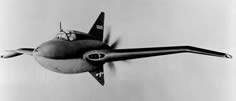
- USAF
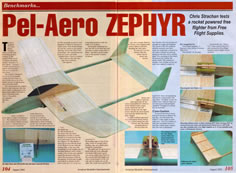
- Aeromodeller, August 2002

- Isacson catalogue, 1960
|
||||||||||||||||||||||||||||||||||||||||||||||||||||||||||||||||||||||||||||||||||||||||||||||||||||||||||||||||||||||||||||||||||||||||
|
|
|
|||
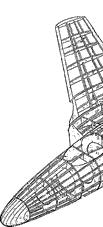
Steve has built up an archive of vintage Jetex jet plans over the last few years, and has made them freely available as PDFs via the Jetex.org website. Here are two (greatly reduced) examples, one from the UK Skyleada range and the other from the US Comet range: |
|

- Paul del Gatto, for Telasco (1958)
|
||
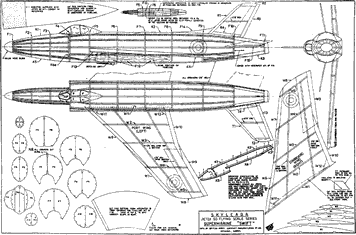
 Having maundered on somewhat these past two months about the chronic unreliability of Rapiers, I am pleased to report that Dr Zigmund appears to have, at last, taken note of the (many) complaints. Steve bought a box of L-2 motors recently. Simply labelled ‘HP’ (Dr Z no longer indicates the date of manufacture or specification, but Steve reckons were about 200mN or so), they were much better behaved. I do not know what changes Dr Z has made, nor what the supply situation will be for lower rated L-2s or the much-desired L-3, but this is encouraging, even if it is, statistically, a very small sample. Back to the building board! Steve, Mike Stuart, Marty Richey and others are busy trying out exciting new designs that they will be happy to share. If you fancy something ‘vintage,’ there is more choice than ever, and the range of plans on-line at Jetex.org (to pluck an example out of the aether) is growing. Not only has Steve made scans (PDFs) of Skyleada and Comet plans, he has also done his considerable best to clean them up, removing photocopying distortions and errors in the originals that, curiously, were not picked up at the time. The Skyleada Hunter, for example, had mismatched wings (see Jet(X) Files, April 2004). If you prefer a laser cut kit, Replikit, now under the aegis of Mike Black’s ‘Green Air Design’, are going from strength to strength. Their Skyleada Vulcan for Jetex 100 (or Rapier L-3) is particularly pleasing, and the Swift and Hunter and will be available soon. I hope the latter will use Steve’s corrected plan! |
|
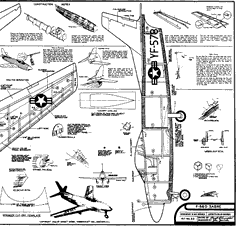 (Left) Skyleada Swift. The nose looks more like that of the Type 517 or F.1. Other Skyleada plans online include the Hunter, Cutlass, Comet and Javelin. (Above) This Comet F-86 Sabre is a great improvement on the KK plan (also available online). Other Comet plans online include the F-94 Starfire, Aircomet, Skystreak and Panther. Though these are, like the Telasco Cougar, more than a little over-engineered (this does seem a characteristic of US designs), and no flying scale model should have an undercarriage, they can, as Steve showed with his Panther, be turned into very nice models that fly well. |
||

That Tom found his Hunter quite a handful with a middle-rated Rapier L-2 may be a result of its small size. Whilst in the early days of Rapiers it was usual to reduce designs originally for the Jetex 50 to 85% or so, subsequent experience has shown that this is not necessary: Mike Stuart’s Mystère IV (a large model) flies quite happily on a Rapier L-2 LT and my own Hunter (built from the ‘a ‘full size’ plan ) goes optimally with a 140mN L-2. Having built a Hunter, one might be tempted to assay that other iconic prototype of the early fifties, the Supermarine Swift. Unfortunately, the ‘vintage’ designs from Skyleada, Keil Kraft and Easy Built are not that inspiring. Part of the problem is that it is not certain which marque is being modelled. Andy Blackwell has compared the plans with each other and with the 3-views in Barrie Hygate’s authorative British Experimental Jet Aircraft (Argus Books, 1990). He reports: “Ray Booth’s Skyleada design is the most accurate – it is probably based on the Type 535/541 – and the bespoke cockpit canopy, wing and built-up tailplane and fin are pretty good. The main body is too slim, and the nose is too short and insufficiently bulbous for the 535, being closer to that of the F.1. Albert Hatfull’s KK design [also probably modelled on the 535/541, but with features of the 517] is again skinny and has more detail inaccuracies: the wing leading edges are not cranked and there is insufficient tip chord, and the all-sheet tail feathers are much too large. The kit was supplied with a generic canopy (which also did for the Sabre, Panther and MiG 15 amongst others), so the accuracy of this crucial feature doesn’t come into it. “The Skyleada plan indicates ½" dihedral and the KK plan ¾". Interestingly, Albert Hatfull has a horizontal motor, whilst Ray Booth angled his motor away from the trough to give a trace of up-thrust. The Easy Built design, though designated ‘FR.5’, is a straight crib of the KK plan with all its inaccuracies. Though bigger – it is 2" longer, for example – what gives it away is that the scarf joints in the keel are in the same places. I built a KK Swift for my Jetex 50C, and reduced the dihedral to that of the Skyleada design (½" each side). This may have been a mistake, as it appeared to fly on the proverbial ‘knife edge’, dipping a wing in either direction. The KK nose is bulbous, but being weak at the intake/nose joint, it snapped off in the first heavy arrival.” Thank you, Andy. I don’t think Andy ever trimmed out his Swift satisfactorily; perhaps it’s time to build another one for Rapier with more dihedral. |
|
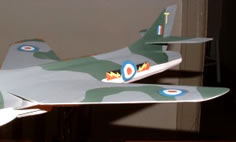
- Tom Rossano
|
||
|
Marty Richey despaired of the ‘KK/Easy Built’ design – it is even more obviously anorexic in the fuselage department – but Howard Metcalfe did manage to turn it into a respectable simulacrum of Mike Lithgow’s all-blue world speed record holder (right, see also Jet(X) Files, July 2004 for how it flies). To conclude: apart from the Bert Judge’s big and beautiful ‘Tailored’ Swift for augmented Jetmaster, Ray Booth’s is the nicest realisation of a difficult design to ‘capture’, and I look forward to the Replikit. But perhaps it could be ‘plumped up’ a bit and converted into the definitive FR.5 before it is issued. Or would this be sacrilege? |

- Howard Metcalfe
|
|||

Like the Keil Kraft design, it has an all-sheet fin and tailplane, but it is in general more accurate than Albert Hatfull’s early and rather strange P.1081/P.1067 chimera, and has many similarities to Ray Booth’s plan (the wings match though). It is a pity the Jetex 50 is exposed and not tucked away in a trough. The ‘CB’ logo bottom left gives a clue to its origin. ‘CB’, a French manufacturer, also produced a kit of the Mirage III in 1958. |
|
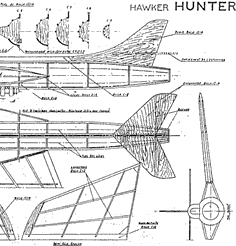
- Pssst Off Sheet
|
||
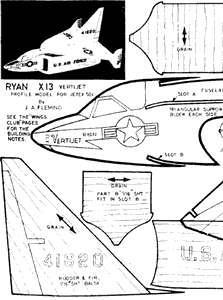
This simple all-sheet design is very attractive, and these sorts of designs, originally for Jetex 50, go very well with Rapiers as there is a considerable weight saving. But note that the Jetex 50C is enclosed within the ‘semi profile’ fuselage, which can have a deleterious effect on the motor’s thrust. I would be very interested in whether its performance with a Rapier L-2 is affected. |
|
 The ‘semi profile’ all-sheet Ryan X-13 Vertijet
- Model Aircraft, March 1960 (p. 79)
|
||
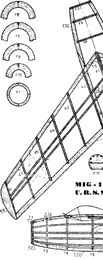
This last comment led me to search out Phil Smith’s seminal article about Jetex scale models in the 1951 Aeromodeller Annual. Phil believed that even swept wings needed dihedral, writing: “The fin area designed into most modern jet designs is totally inadequate for model use. The amount of fin area to be added cannot he generalised, but is best arrived at by trial and error under flight conditions […] swept-wing types, such as the Sabre, require less dihedral than the conventional wing types, but should be about 1" for every 10" span each side of the fuselage”. One scale model that would need perhaps less fin area than the prototype would be the Russian MiG 15. “The fin and tailplane [of the MiG 15] are so highly located in relation to the thrust line that spinning tendencies are bound to be a heritage of a model which is not accurately trimmed and balanced. A better design by far is the Lavochkin 17 with reasonable fin area and a high wing placing”. Hmm … perhaps, after all, Bill Dean got it right with his MiG 15, and the ‘redundant’ dihedral balances the very large fin, (a feature the MiG 17 shares), giving side area and providing spiral stability. Did Marty need to reduce the fin area, allowing, as Andy Sephton would say, the model to ‘side slip out of a spiral’? Marty cogitated on all the impertinent (and contradictory) advice he was given on the Jetex.org Discussion Forum, and moved the motor so its nozzle sat over a more rearward CG. Marty then reported, “With a 110mN motor, departure to left or right downward spirals reoccurred; I rebalanced to glide flatter and faster, getting a complete, if sedate, flight.” In the light of further test flights Marty wrote, “The MiG 17 is very sensitive to thrust/speed; assuming the model will always fly better slower, the very thin wing section was wrong, but if I can get the nose up into a strong spiralling climb it may show an advantage. The most constructive modification I made was to angle the motor 3-4 degrees into the trough, [enabling a change from ‘purposeful glide’ to an ‘extended performance glide’] … even with 110mN thrust the flight profile is somewhat unpredictable and often ends in an aerobatic routine… still, aerobatic is better than many quick ground-arrivals.” |
|
 MiG 15 plan published in an Italian aeromodelling magazine. Bill Dean is not credited
- Systema Practico, Dec. 1953
|
||
|
Like Marty, Hubert built his model (right) without dihedral, though he did put in plenty of washout. Not surprisingly, given Marty’s experiences, he approached test flying with some trepidation. The best advice seemed to be to try to fly it with ‘a whiff of power’. Hubert reported, “I had three flights, surprisingly without any spiralling. I loaded an 85mN motor first and it was slow and stable but at low altitude. After that I put in a 120mN rated motor which gave an almost perfect flight under power, but without power, flight was very fast to the ground.” Hubert modified the tailplane give a degree or so more incidence. With 110mN rated motors it now flies well enough to be recorded on video – flying beautifully, alas, into a tree! Hubert is now on his fourth version. Obviously made of the right stuff, he comments, “The MiG 17 is lot of fun because it's not an easy model.” So there we are: I was going to build another MiG 15 (to replace one burned up last year) without any dihedral at all; now, I’m not so sure. Anyone for a MiG 19? |
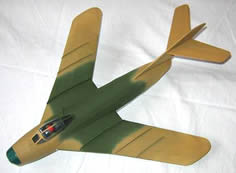 Hubert Kostrzewa’s MiG 17 for Rapier L-2
- Hubert Kostrzewa
|
|
|
|
|
|
|
|
|
Acknowledgements - Article: Roger Simmonds - Illustrations: Roger Simmonds, Alec Hutchison, Grif Ingram, Hubert Kostrzewa, Peter Lloyd, Howard Metcalfe, Tom Rossano, Peter Williams |
|
|
|
|
ABOUT | MOTORS | MODELS | ARCHIVE | HISTORY | STORE | FAQ | LINKS |
|
|
Terms of Use
|
Queries? Corrections? Additions?
Please
contact us.
|
|